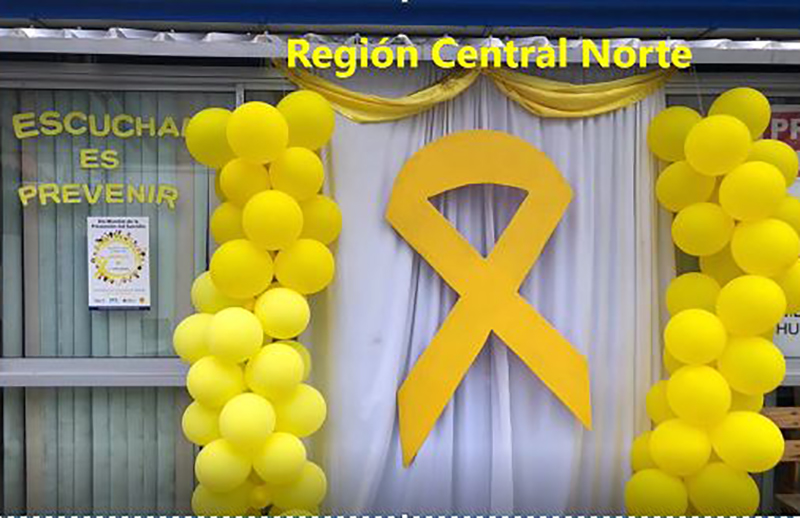Psychologist Catalina Calderón works for the Costa Rican Ministry of Health in the North Central Health Administration. This region encompasses the entire province of Heredia and five cantons of Alajuela: Río Cuarto, Grecia, Atenas, Póas and the capital of Alajuela.
Like Dr. Ninfa Salas in the Huetar Norte Region, the protagonist of yesterday’s story, Catalina works in a region with diverse geographies and contexts, from urban to extremely isolated rural communities.
But they have one thing in common: high suicide rates, which have risen during the pandemic.
Ninfa is coordinating mental health training workers from the Costa Rican Social Security Fund, or Caja. Catalina works in a different region and from a different angle, the Health Ministry, bringing together public and private institutions—national, regional, and hyperlocal, like a church group for grieving mothers—so that diverse mental health support needs can be met even when the Ministry or the Caja have limited financial resources.
This psychologist specializing in suicide prevention gives top priority to her region’s IRAIS and ILAIS: Regional and Local Instances for a Comprehensive Approach to Suicide Risk. However, she says her work also covers a wide range of topics, from drug use prevention to working with schoolchildren on managing emotions.
El Colectivo 506 spoke with Catalina via Zoom about the myths surrounding suicide in Costa Rica, the limitations she’s discovered through her work, and the power of alliances. The conversation has been edited for clarity and brevity.

How did this effort start for you?
In order to be able to work on mental health in community terms, we began to analyze that we should work on mental health, first internally—that is, at home. So we developed a mental health program for [Caja] workers.
Subsequently, we worked on a methodology that consisted of elective workshops where different topics were offered to the population: life skills, managing emotions, limits in the home. What happens at home when I, as a health worker, take care of my parents because they are ill, or because they are older adults? We also coordinated with other institutions for talks on mourning, prevention of drug use, and other topics. We have worked on this from 2015 to the present day.
This coincided with the publication of Decree 40-881 [N° 40881 – S, “Officializing the National Regulations for Interinstitutional Articulation in the Comprehensive Approach to Suicidal Behavior, February 22, 2018]. This regulation says that when cantons and regions already have mental health networks, they have to incorporate suicide prevention—and it points out that those that do not have networks, have to create them.
This brings in, for example, f the Red Cross, the National Police, NGOs, the MEP [Ministry of Public Education], the PANI [National Children’s Protection Agency], the IAFA [Institute on Alcoholism and Drug Addiction], and others. Each instance must develop work plans, focused on three axes of what the Technical Secretariat for Mental Health has indicated: prevention, care and promotion of protective factors for mental health. So, for example, if someone asks me for [support to prevent] substance use, I know that I can count on the IAFA.
Since the start of the pandemic, we’ve partnered with a platform called Yamba Radio. Every week, we bring them mental health programs. We have talked about autism, managing emotions, mourning. We have joined forces with Paniamor, with the TeenSmart Foundation, various universities, hospitals. When we see the number of people who’ve listened, we realize that we are reaching the population. We cannot say that there is behavioral change, but we do know that the message is getting out there and that it is a resource for them.
Training for medical workers seeks to reduce mental health care gap in Costa Rica
How has this network served you to deal with the issue of suicide in particular?
It’s one thing to work on mental health and for me to come in and say, “I’ll give a talk on regulating our emotions,” right? But when I bring up the subject of suicide, you can feel the fear. You feel people suddenly react, like, “I just don’t know what to say. I don’t know what to do.” We try to open these spaces and take the messages to the community level so that people lose their fear, and listen.
We begin to break down these myths.
What are some myths about suicide that are prevalent in Costa Rica?
There is a myth that it is very, very, very dangerous. It is silence, because suicide feeds on silence. So the more I can generate spaces where I can talk to people, explain to them… the more I can tell them to talk about it.
Sometimes we naturalize behaviors. Parents will tell me, “It’s just the way this kid is. It’s his temperament. He always came home, locked himself in the room, and what were we supposed to do?” But we need to analyze what that behavioral language is telling us. Sometimes that’s very difficult to put into words.
How many times do we see someone cry, and we don’t ask what’s wrong? Or we say, “Look, don’t cry,” right? There are sociocultural issues of patriarchy…Sometimes the messages given to the male population are, “Don’t cry. Be strong. Don’t be” —excuse the expression—a maricón… We give them those harsh messages, and sometimes, when this population can’t take it anymore… they opt for suicide, because they don’t know how to ask for help.
And there is the myth that only trained mental health professionals can help someone at risk of suicide, or in crisis. That weakens the ability of the general public to take action.
We can listen. And after we listen?
Then we activate. We call 911. We call the relatives. We have to raise awareness, because people continue to have that resistance of “No, because later they might kill themselves because I’m not a psychiatrist, and I don’t even know what to say.” In reality, it’s all about listening. Then you can act accordingly.
In our network, we have a plan that has served us as a draft, where we know what to do with suicidal ideation, attempted suicide. If there is a suicide, we try to coordinate with the survivors, who are all the suffering people around to loss.
What are the limitations you have encountered? What needs to be improved in Costa Rica or in your region to strengthen these community networks?
We’ve found many deficiencies in the system that I have reported to the Mental Health Secretariat. I hope it changes. I dream of my country being advanced, just like Spain or Argentina, where they have specialized institutes for people at risk of suicide, or even that they different treatment—because suicidal ideation is not the same kind of emergency as getting shot and going to the hospital. There is still a long way to go to show that suicide is a distinct kind of emergency.
My dream is to have a community model for suicide prevention and a mental health approach… The Secretariat asked me to do a community project and what I first proposed was a mental health assessment, but they rejected the proposal.
How much information do you have about mental health in your area, and what is missing?
We have lots of information in Costa Rica. Regulation No. 40556-S [Health Surveillance Regulation] indicates which events require mandatory notification. Items that must be reported include attempted suicides, so I know which areas of my region have higher rates of attempted suicide.
Any official, in any public institution, is required to report?
Exactly—from any public or private institution. Even private doctors have to notify, and not just attempted suicide: there are other disorders or problems related to mental health that have to be reported, such as depression, schizophrenia, bipolarity, or developmental disorders such as autism.
What would your proposed assessment do to supplement the data you already have?
It’s not that there’s no information: it is that you have to sit down and really sift through it, and sometimes you don’t have the time. To give you an example, we recently realized that there is a group of people with anxiety who meet in one of our communities to support each other. I think it’s an excellent resource, because many patients get prescribed anxiety medication, and then they say, “Now what do I do? What’s out there in the community?” Or there are bereavement groups that work with mothers who have lost a child. So, let’s say that a lady comes to me and says, my son died last year and another child just committed suicide. I already know that we have to coordinate this with the Caja, but the fact that I know that there is a group helps me.
So we need to have that map of what else is out there.
Even though they have not approved the assessment, we have to do it. They rejected it because they want the whole country to have the same assessment, the same guide. In theory we are going to start the process… in the next few months. Let’s hope.






